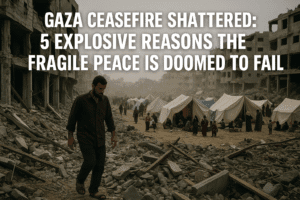Gaza Ceasefire Shattered: 5 Explosive Reasons the Fragile Peace Is Doomed to Fail
Hamas has formally responded to the U.S.-brokered ceasefire proposal, offering to release 10 living hostages and 18 bodies. However, the group’s acceptance is fractured by major demands: a full Israeli troop withdrawal from Gaza and a permanent end to the war. Israel, having accepted the initial U.S. framework for a 60-day pause, finds these conditions unacceptable, as its core objective remains dismantling Hamas. This reveals the fundamental impasse – Hamas seeks survival and permanence, Israel demands security guarantees incompatible with a full withdrawal now.
The diplomatic stalemate persists while Gaza’s humanitarian crisis worsens, with over 54,000 Palestinians killed and aid critically blocked. Mediators face the immense challenge of bridging these irreconcilable positions as suffering deepens daily.

Gaza Ceasefire Shattered: 5 Explosive Reasons the Fragile Peace Is Doomed to Fail
The latest chapter in the devastating Gaza conflict hinges on a delicate diplomatic exchange. While headlines announce Hamas’s response to the U.S.-brokered ceasefire proposal, the reality beneath the surface reveals a precarious stalemate where profound disagreements threaten to unravel even tentative progress.
The Current State of Play:
- Hamas Breaks Silence: After days of anticipation, Hamas formally delivered its response to mediators regarding the U.S. proposal, which Israel had already accepted. This proposal centered on a 60-day ceasefire.
- A Partial Gesture: Crucially, Hamas stated its willingness to release 10 living hostages and the bodies of 18 deceased individuals still held in Gaza. This represents a potential humanitarian step forward for affected families.
- But the Devil is in the Details: The statement, however, is far from an acceptance. Reports from both Arab and Israeli media sources indicate Hamas has laid down significant conditions, primarily:
- Complete Israeli Withdrawal: A demand for the total pullout of Israeli Defense Forces (IDF) troops from the Gaza Strip.
- A Permanent End to the War: An insistence that any ceasefire agreement must be permanent, definitively ending the current conflict phase.
The Sticking Points: Why a Deal Isn’t Done
The core impasse lies in fundamentally incompatible goals:
- Israel’s Stated Objective: Israel launched its military campaign with the declared aim of dismantling Hamas’s military and governing capabilities. Accepting a full withdrawal and permanent ceasefire without achieving this core objective is politically untenable for the current Israeli government. A temporary halt, perhaps, but not an end.
- Hamas’s Survival Imperative: For Hamas, securing a permanent ceasefire and Israeli withdrawal is existential. It aims to retain some form of control or influence in Gaza post-conflict. A temporary pause that allows Israel to regroup and resume operations later is seen as insufficient.
- The Trust Deficit: Two decades of conflict and the trauma of the October 7th attacks have obliterated trust. Neither side believes the other will uphold commitments made under a temporary truce, making the demand for permanence from Hamas and the demand for continued operational freedom from Israel mutually exclusive in the current context.
The Crushing Human Context:
This diplomatic maneuvering unfolds against a backdrop of staggering human suffering:
- Mounting Casualties: The reported Palestinian death toll exceeding 54,000 (predominantly civilians, including many women and children) underscores the conflict’s horrific scale.
- Humanitarian Catastrophe: Images of Palestinians sifting through rubble in Gaza City and families relying on aid distributions in makeshift tent camps (like those in Khan Yunis) illustrate the near-total collapse of infrastructure and the desperate struggle for survival. The blockage of aid, leading to food rotting in Jordanian warehouses while Gaza starves, highlights the systemic failure to address urgent humanitarian needs.
- Hostage Anguish: The plight of the hostages and their families remains a raw wound in Israel, a constant reminder of the attack’s brutality.
The Stakes and the Path Ahead:
The U.S. proposal represented a significant diplomatic effort to halt the fighting, even temporarily. Hamas’s response, while offering a potential path to hostage return, simultaneously introduces demands Israel categorically rejects. This leaves mediators with a near-impossible task: bridging an enormous gap rooted in survival, security, and profound mutual distrust.
Insight & Value for the Reader:
This isn’t just another “Hamas responds” update. It’s a critical juncture revealing the deep structural obstacles to peace:
- The Illusion of Simplicity: Releasing hostages is complexly intertwined with ending the war itself. One cannot be easily separated from the other in the parties’ calculations.
- “Permanent” vs. “Temporary”: This isn’t semantic quibbling. It reflects the irreconcilable core aims of each side – survival for Hamas versus perceived security for Israel.
- The Mediation Quagmire: Even with U.S. backing, mediators face the Herculean challenge of finding language or phased approaches that both sides can accept without feeling they’ve sacrificed their fundamental objectives.
- The Human Cost of Delay: Every hour spent negotiating while the underlying demands remain unmet means more lives lost, more families shattered, and more infrastructure destroyed, deepening Gaza’s humanitarian abyss.
The coming days will test whether there is any flexibility beneath the public posturing or if the mutually exclusive demands condemn Gaza and its people, along with the hostages, to further devastating conflict. The hope for a respite hangs by a thread, frayed by the very issues that ignited the war nearly 20 months ago.
You must be logged in to post a comment.